Essential Foundations of Cremation Containers
A cremation tray is a specialized container designed to hold and transport human remains during the cremation process. If you're looking for quick information about cremation trays, here's what you need to know:
- Purpose: Provides dignified containment and transport of remains into cremation chamber
- Materials: Typically made from corrugated cardboard, wood composite, or pinewood frames with plywood bases
- Standard Dimensions: 80" x 24" x 4" (external); 78.5" x 22.5" x 3.5" (internal)
- Weight Capacity: Ranges from 350 lbs (economy) to 1000+ lbs (reinforced/oversized)
- Types: Basic trays, leak-resistant, viewing trays, combo/air trays for shipping
- Price Range: $49 to $155 for standard trays; up to $1,155 for specialized shipping containers
The funeral industry relies on cremation trays as essential tools for maintaining dignity throughout the cremation process. These purpose-built containers provide structural support while facilitating efficient transfer of remains into cremation chambers.
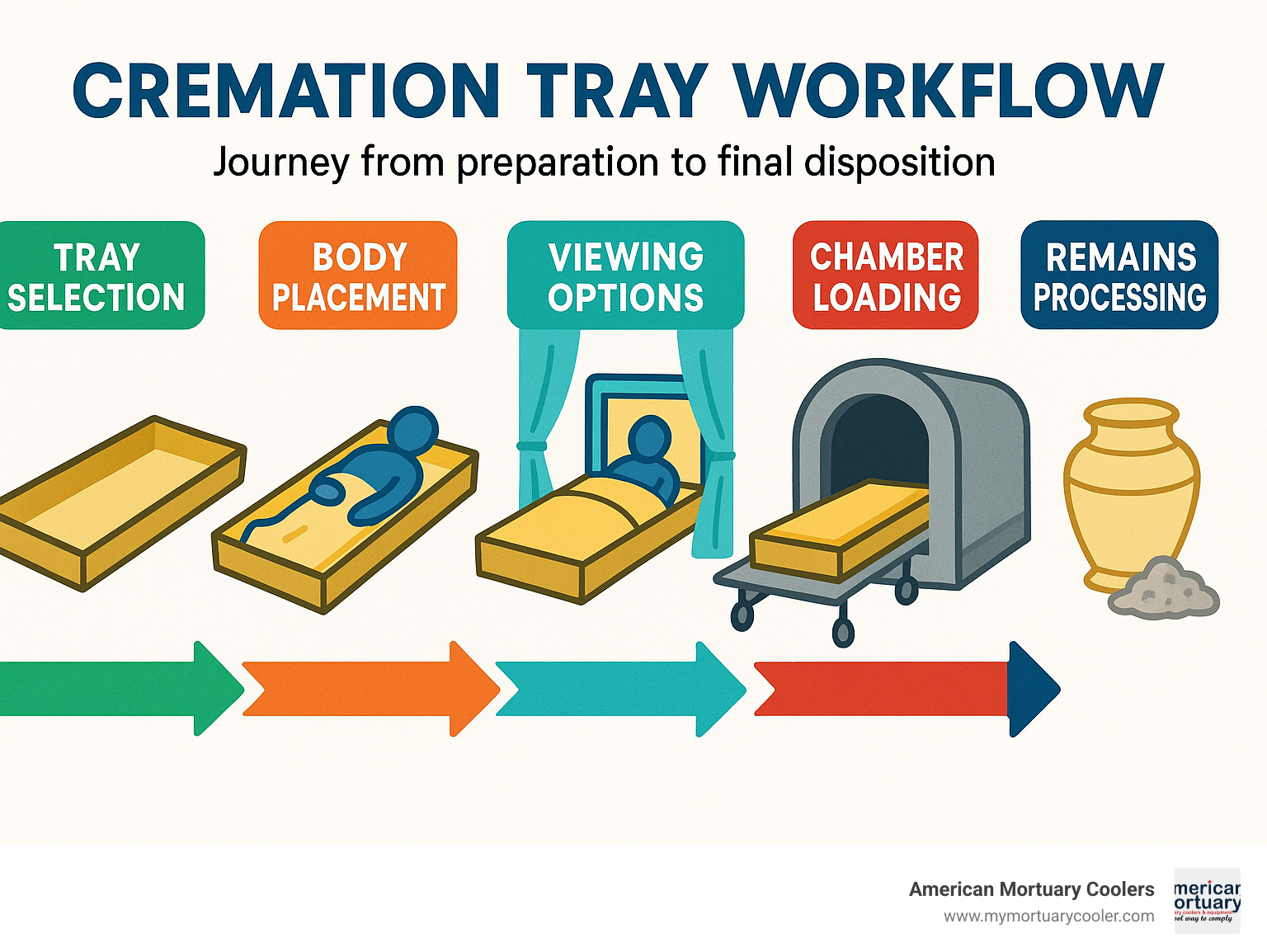
Easy cremation tray word list:
Why This Guide Matters
As cremation rates continue to rise across the United States, funeral professionals face increasing pressure to optimize their cremation processes. This guide matters because:
Regulatory Compliance: The FTC Funeral Rule requires that funeral homes offer simple, unfinished containers as an alternative to caskets for cremation.
Cost Management: With the right knowledge, funeral directors can select appropriate cremation trays that balance quality with cost-effectiveness.
Sustainability Goals: Many funeral homes are adopting greener practices. This guide helps identify environmentally friendly options.
Operational Efficiency: The right tray can streamline handling, reduce staff strain, and improve overall workflow.
At American Mortuary Coolers, we understand these challenges firsthand. From our locations across the country, including Atlanta, Chicago, Dallas, and New York, we've helped countless funeral homes optimize their cremation equipment and supplies.
Understanding Cremation Trays: Definition, Purpose & Benefits
What Is a Cremation Tray?
A cremation tray is the unsung hero of the cremation process – a thoughtfully designed, single-use container that safely transports human remains into the cremation chamber. Unlike elaborate caskets, these practical containers focus on functionality and efficiency while maintaining dignity.
Each tray typically features a sturdy base made from plywood or heavy corrugated material, structural sides to properly contain remains, a simple lid for coverage, and carrying handles for safe transport. Many modern trays include absorbent materials to manage fluids with care.
These trays fulfill an important regulatory role too. The FTC Funeral Rule requires funeral homes to offer "alternative containers" – non-metal, unornamented enclosures designed specifically for cremation. Cremation trays meet this definition perfectly, giving families a dignified, cost-effective option.
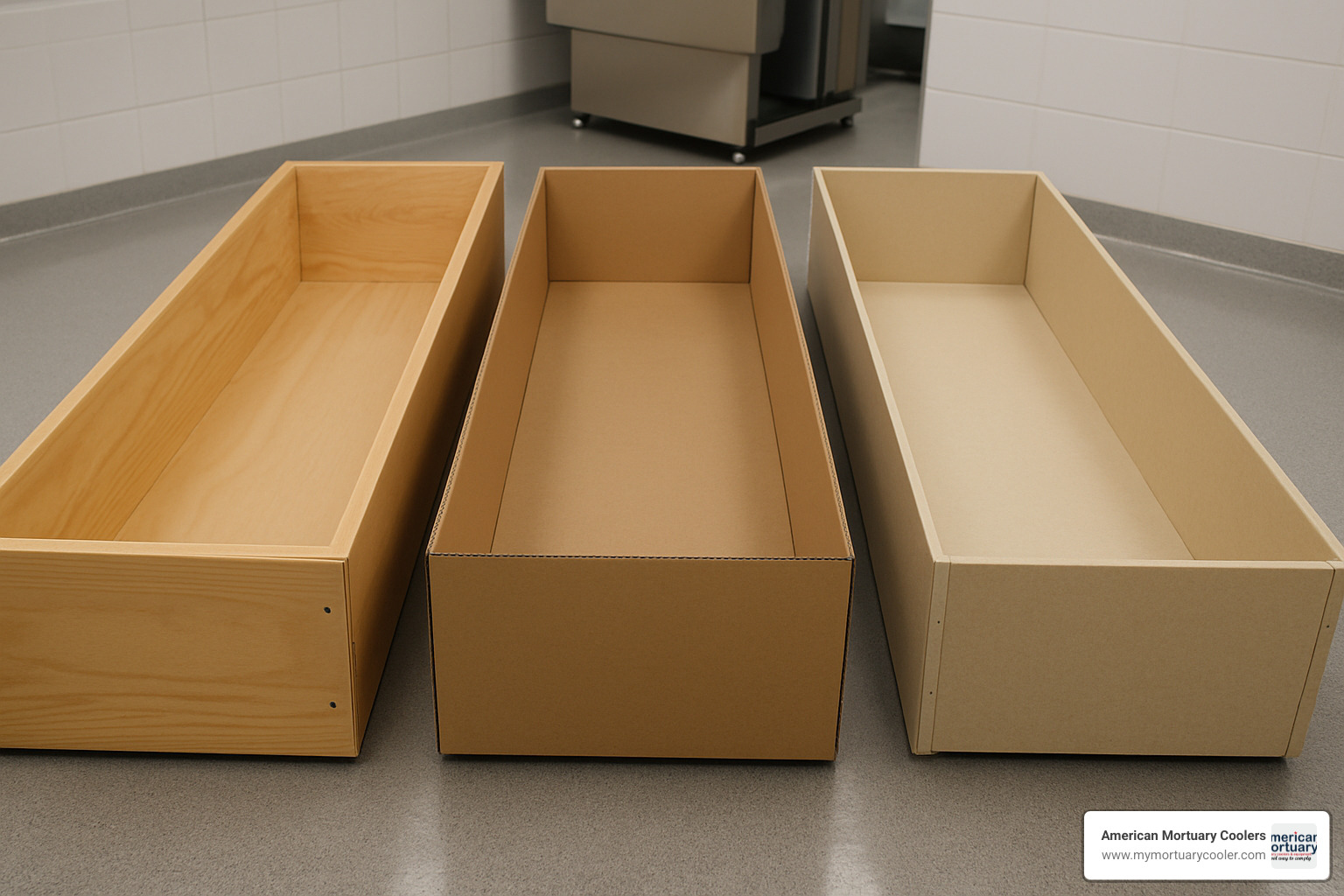
Key Benefits for Funeral Homes & Crematories
When it comes to running a smooth operation, cremation trays deliver benefits that make a real difference for funeral professionals.
Your staff will appreciate the time efficiency these trays provide. Their straightforward design means quick preparation and loading, allowing you to maintain a respectful pace between services.
Staff safety is another major advantage. Well-designed trays include sturdy handles and appropriate weight ratings that help prevent injuries during transport and loading.
Modern cremation trays also feature excellent leak control through resistant bases and absorbent materials. This thoughtful engineering contains bodily fluids, protecting your facility, equipment, and staff.
For families, even basic trays provide peace of mind through dignified containment. Viewing trays offer an especially meaningful option for final goodbyes without the expense of a rental casket.
From an operational standpoint, standard trays are designed for perfect compatibility with modern cremation equipment. They work seamlessly with rollers, lifts, and chamber dimensions.
Here at American Mortuary Coolers, we've witnessed how quality cremation containers complement our cooling systems to create a complete, efficient operation. For deeper insights into how cremation trays work with cremation chambers, check out our practical guide to cremation chambers and the cremation process.
Materials, Sizes & Weight Capacities
When it comes to cremation trays, the materials, size, and weight capacity aren't just technical specifications—they're essential features that ensure dignity, safety, and efficiency.
Construction Materials
Corrugated cardboard trays offer lightweight handling and clean burning with minimal ash residue. These range from basic single-wall designs to heavy-duty triple-wall construction, with weight capacities increasing accordingly. The most robust triple-wall trays can reliably support up to 715 pounds while remaining surprisingly light.
For situations requiring additional structural support, pinewood frames with plywood bases provide exceptional stability. These wood-based trays typically feature 1"×4" pine framing with a 3/8" plywood bottom—creating a sturdy platform that maintains its integrity during transport.
Many modern cremation trays also incorporate leak-resistant features through polymer coatings or specialized inserts. These thoughtful additions work alongside absorbent pads to maintain dignity and cleanliness throughout the preparation process.
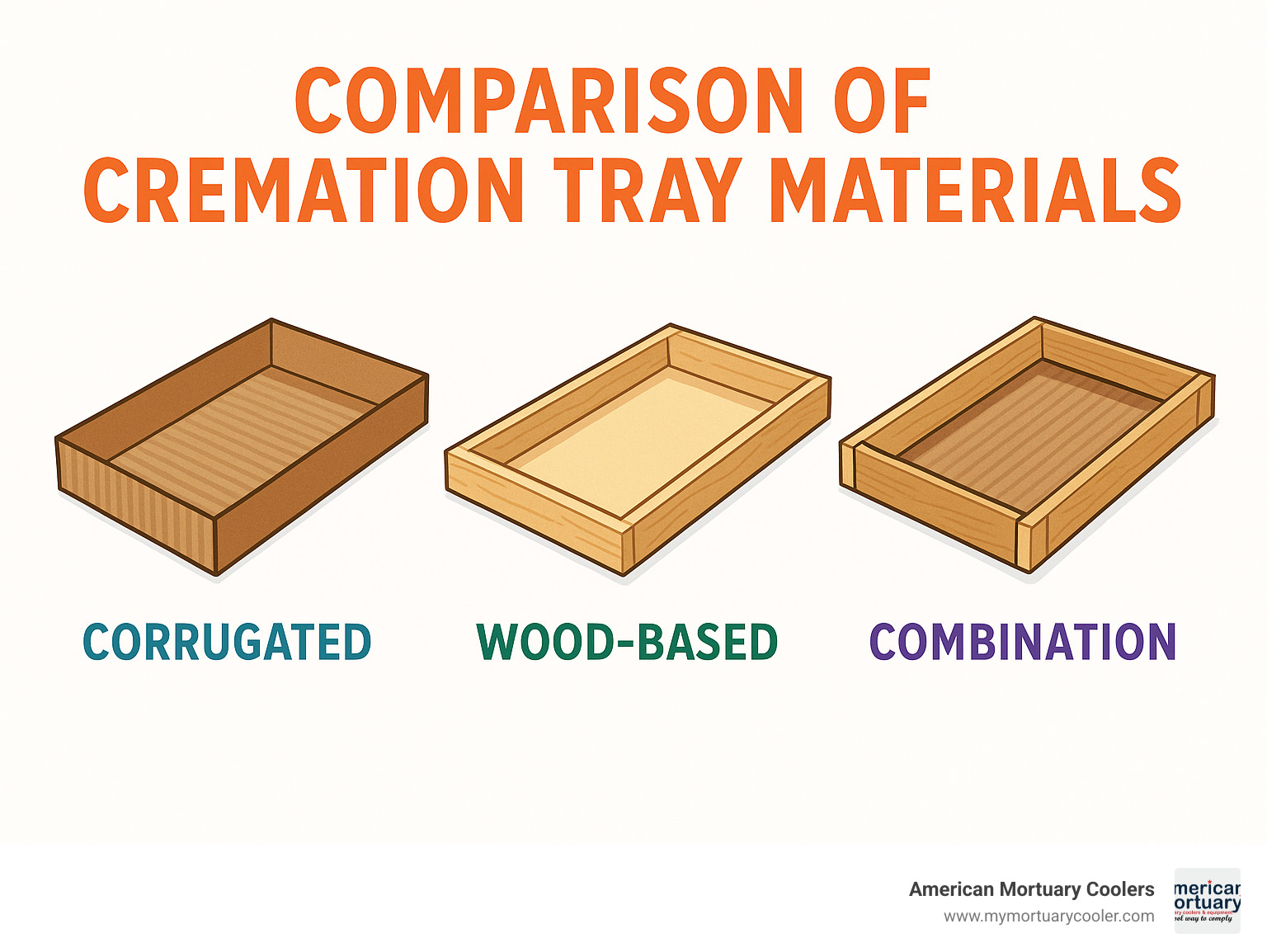
Standard, Oversized & Infant Cremation Tray Dimensions
Standard adult trays typically measure 80" × 24" × 4" externally, with internal dimensions of 78.5" × 22.5" × 3.5". These accommodate most adults with weight capacities ranging from 350-500 pounds for economy models.
For those requiring more space, oversized options offer additional width at 28" or 30". The 28" Deluxe Cremation Tray provides exceptional support for up to 1000 pounds, while the Triple Wall 30" width trays comfortably handle up to 715 pounds.
We also understand the need for smaller options. Youth trays (approximately 48-60" in length), child trays (36-48"), and infant trays (24-36") are all proportionally sized to provide the same level of respectful containment for younger individuals.
Performance & Safety Testing Protocols
Quality manufacturers conduct drop tests that simulate the stresses of lifting and moving the tray with remains. Load testing verifies that weight capacity claims hold true under both static conditions and during movement. Heat resistance testing ensures predictable, appropriate combustion behavior during cremation.
For leak-resistant models, absorbency testing measures fluid containment capabilities. Clear orientation labeling is also verified to ensure proper placement within the cremation chamber.
At American Mortuary Coolers, we understand how cremation trays integrate with your complete workflow. Our custom mortuary coolers are thoughtfully designed with consideration for the entire process, including the dignified transfer of remains to cremation containers.
Types of Cremation Trays & Must-Have Features
Shopping for cremation trays can feel overwhelming with all the options out there. Let me walk you through the main types you'll encounter and what makes each special.
Wood-Based & Combo Trays
When you need something truly sturdy, wood-based cremation trays are your go-to option. They simply feel more substantial in hand, which can be reassuring when handling heavier remains.
These workhorses typically feature a pine frame built from 1"×4" boards with either OSB or 3/8" plywood forming the base. Most come with six strategically placed poly handles that make lifting safer and more balanced for your team.
For shipping situations, combo trays (sometimes called air trays) take durability to another level. They're essentially the heavy-duty pickup trucks of the cremation world, featuring all-plywood construction with solid wood reinforcement along the tray sides.
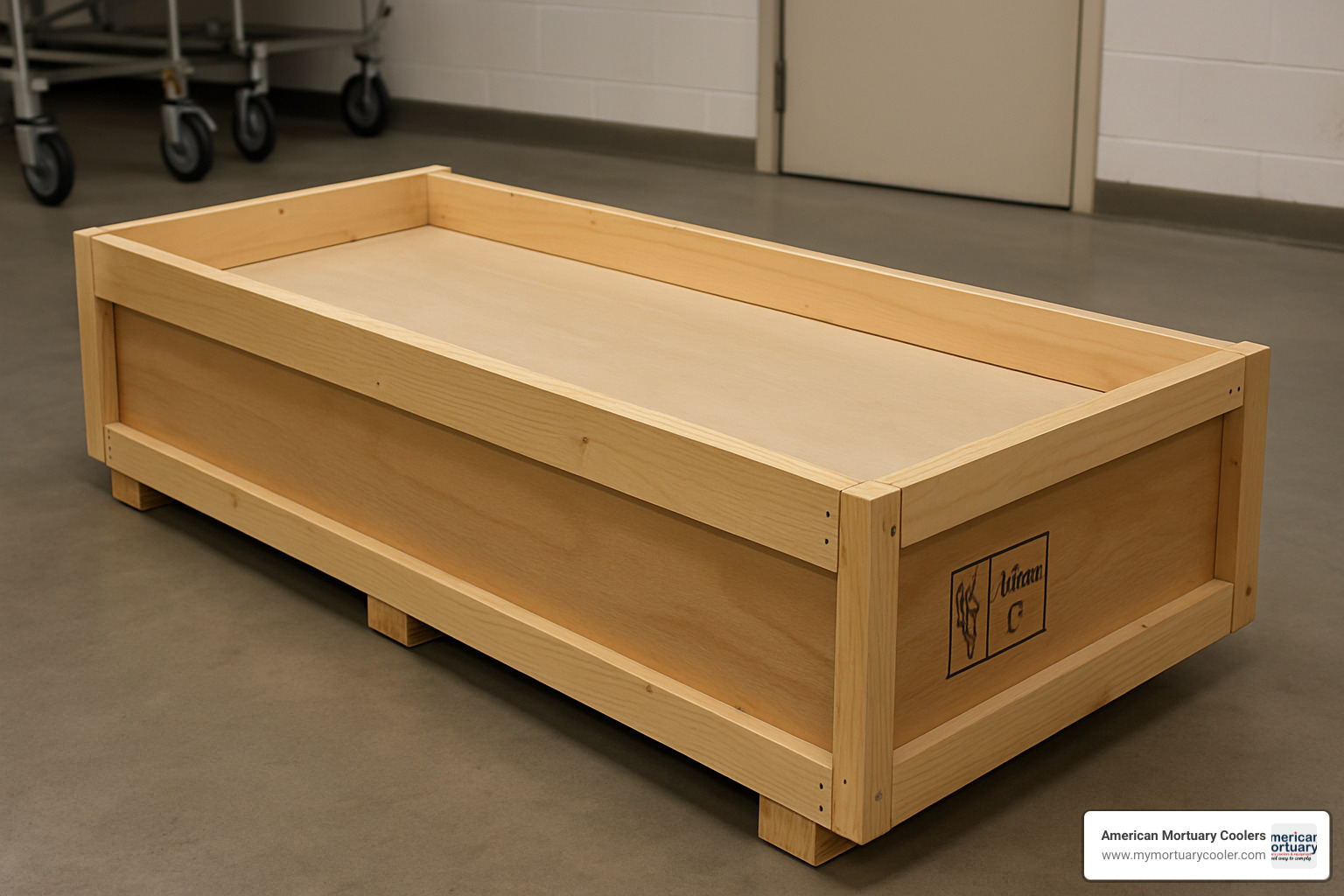
Look for the international heat-treated certification stamp (funeral directors often call this the "bug stamp") – it's essential if you're shipping remains. These containers also include multiple tie-down and body straps, plus corner covers to prevent damage during transit.
Corrugated & Triple-Wall Options
I've noticed more funeral homes switching to corrugated cremation trays in recent years. They're environmentally friendlier and burn much cleaner in the retort.
Standard models use double-wall 350 lb test corrugated material for the base, while premium options feature triple-wall military-grade construction that can support up to 715 pounds. Despite this impressive strength, they weigh significantly less than wood alternatives.
The clean-burning properties of corrugated materials leave less residue in your cremation chamber – a hidden benefit that can extend the life of your expensive crematory equipment. You can choose between standard 24" or wider 30" options depending on the needs of those you serve.
If you're looking for industry-standard supplies, the NFDA Business Exchange offers a variety of quality corrugated and triple-wall cremation tray options.
Leak-Resistant & Folding Economy Designs
Leak-resistant models feature polymer-coated corrugated material with built-in absorbent pads or liners. They typically include wood runners (1"×4"×60") to reinforce the structure while maintaining a double-wall 350 lb test corrugated base.
If storage space is at a premium in your facility, folding economy designs might be your best friend. These space-savers ship flat to reduce freight costs while still supporting up to 350 lbs when assembled. Many facilities order these 50 at a time on a single skid, keeping them ready for when they're needed.
Viewing & Service-Ready Trays
Sometimes families want a viewing without the expense of a rental casket. That's where viewing cremation trays shine, offering dignity without unnecessary cost.
These service-ready options feature a crepe interior lining that creates a finished, respectful appearance. Head and foot couch covers ensure proper positioning, while a fabric middle strap provides secure containment. Most include a pillow, drape, and sheet – those small touches that make a big difference to families.
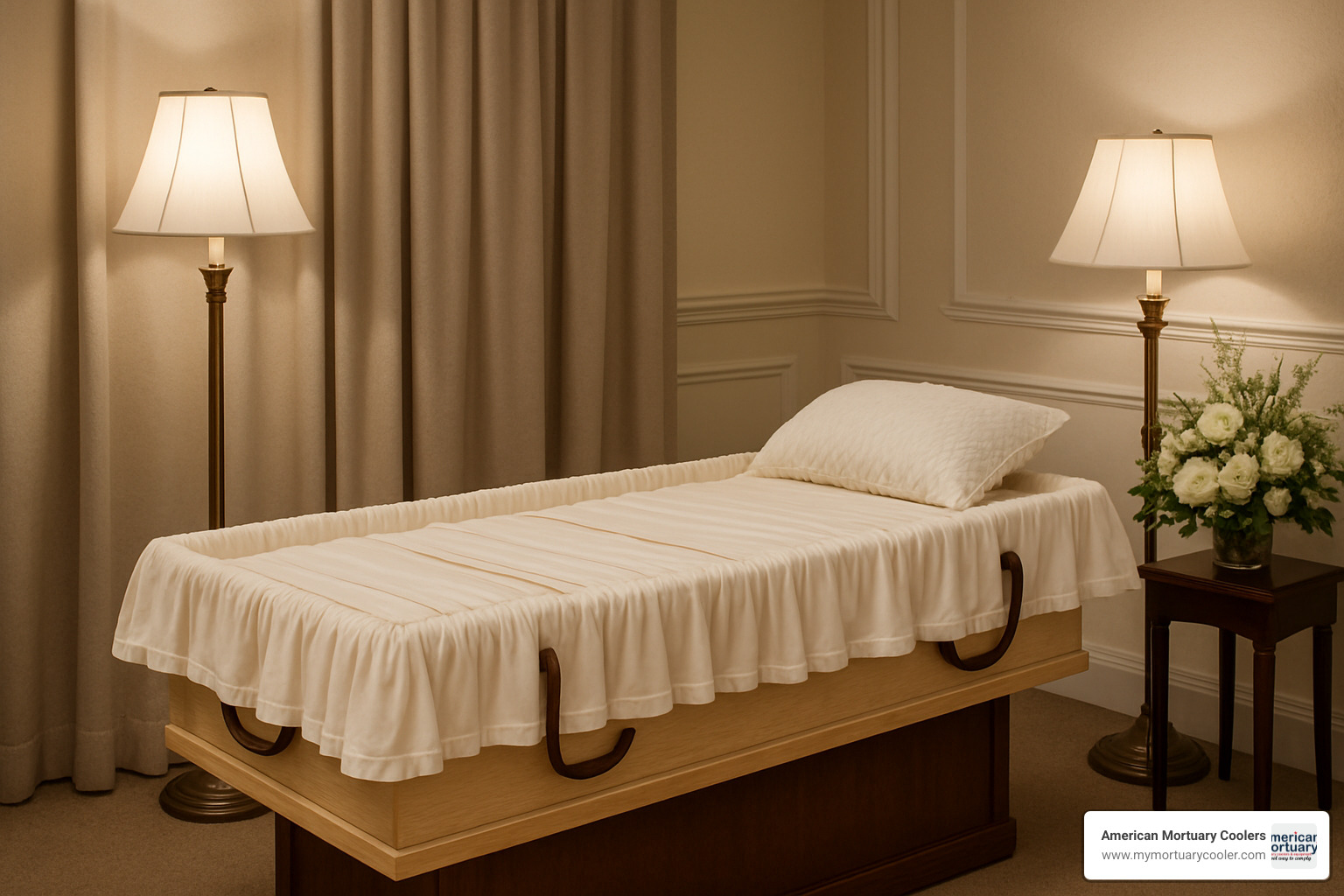
The Deluxe Millennium Cremation Tray with Viewing is a perfect example, bridging the gap between functionality and presentation. These trays give you a middle-ground option to offer families – more dignified than direct cremation but more affordable than a traditional service with casket.
Selecting the Right Cremation Tray: Regulations, Shipping & Sustainability
Navigating cremation trays gets a bit more complex when you need to consider regulations, shipping requirements, and environmental impact. Let's break down what you need to know to make informed choices.
Domestic vs. International Shipping Requirements
For domestic shipping within the US, things are relatively straightforward. You'll need air trays that meet airline carrier requirements. Most carriers require six handling straps and a securing strap to ensure safe transport. Don't forget that white orientation label that shows which end is which.
International shipping requires more careful preparation. These shipments must use containers with IWP (International Wood Packaging) heat-treated certification, complete with the "bug stamp" showing compliance with ISPM-15 standards. For certain countries, you might need zinc-lined shipping boxes, which start around $1,155. Corner covers and multiple tie-down straps aren't optional here; they're mandatory.
If you're shipping cremated remains rather than intact bodies, different rules apply. You'll need TSA-approved temporary containers for air travel, special mailer boxes designed specifically for cremated remains, and you must follow USPS regulations requiring proper labeling and double containment.
Understanding these requirements helps you avoid costly delays and gives families peace of mind knowing their loved one will arrive without complications.
Environmental Considerations & Clean-Burn Choices
As more families ask about green options, the environmental impact of cremation trays deserves thoughtful consideration.
When it comes to emissions during cremation, corrugated trays generally produce less than their wood-based counterparts. If you're looking for the cleanest burn, triple-wall trays perform better than OSB or plywood options. For the most eco-conscious families, willow or other plant-based trays offer truly biodegradable alternatives.
Many corrugated materials contain recycled content, while wood-based trays typically use fast-growing pine species. Some manufacturers now offer trays made from sustainable forestry practices, which appeals to environmentally conscious families.
For funeral homes building their brand around green practices, specialized biodegradable options are becoming increasingly important. Scientific research on green funeral trends confirms what many of us are seeing – consumer interest in environmentally friendly options continues to grow steadily.
Essential Accessories & Best Practices
Let's face it—even the best cremation tray needs a few supporting players to truly shine. These accessories aren't just nice-to-haves; they're essential tools that help your team work safely while maintaining dignity.
Essential Accessories
For safe and efficient handling, cardboard rollers are absolute lifesavers—they create a smooth glide when inserting the tray into the cremation chamber, reducing strain on your staff. Body straps secure remains during transport, preventing shifting that can make handling awkward or unsafe.
Fluid management is another critical concern. High-quality absorbent sheets (typically 40"×90") handle this delicate aspect with dignity. Meanwhile, simple head blocks ensure proper positioning throughout the process, and ID discs maintain positive identification from start to finish.

For families choosing viewing options, presentation accessories transform a basic cremation tray into a dignified setting. Privacy panels create a more comforting visual experience. Fabric sets with sheets, pillows, and drapes add warmth and familiarity. Head and foot couch covers provide proper positioning that looks natural and respectful.
Setting Up for Dignified Viewing and Safe Loading
When preparing for viewing, start by positioning the cremation tray on a stable, level surface. If you're using a viewing tray, install the head and foot couch covers first, then place absorbent materials as needed (discretely, of course).
The linens come next, beginning with the bottom sheet, followed by positioning the pillow and adding the top sheet and drape. Make sure the middle strap is secure but not visible. Always verify that the orientation label is correctly positioned so there's no confusion later.
For safe loading and transport, always use the designated handles or straps when lifting a cremation tray. This isn't just about respect—it's about keeping your team healthy and injury-free. Maintain proper body mechanics with at least two people lifting (more for heavier cases). Those cardboard rollers we mentioned earlier are essential when transferring into the cremation chamber.
Before final disposition, double-check that the orientation label faces upward and remove all non-combustible identification. These simple steps prevent complications and maintain the chain of identity throughout the process.
For more detailed information about how cremation trays work with cremation equipment, take a look at our article on the role of cremation retorts in the cremation process.
Cost & Ordering Considerations
Let's talk about the dollars and cents of cremation trays - because budget matters just as much as quality when running a funeral home.
Price Ranges and Value Factors
When it comes to cremation tray pricing, you'll find quite a range depending on what you need:
Most basic wood-based trays will set you back about $75-$95 each, while standard corrugated options are more budget-friendly at $49-$75. Leak-resistant models typically cost between $85-$115.
For viewing trays with fabric interiors, expect to pay $125-$155. Oversized trays with 28"-30" widths cost around $95-$129. Infant and child sizes generally range from $49-$65.
Combo trays for domestic transport usually cost $95-$155. International shipping gets considerably more expensive, ranging from $155 up to $1,155 for specialized containers.
Buying in bulk can save you significantly. Most suppliers offer tiered pricing:
- Buy 1-24 units and you'll pay standard pricing
- Order 25-99 units for a moderate discount
- Purchase 100+ units to get the maximum savings
When evaluating which trays make the most sense for your funeral home, consider the full picture: durability, weight capacity, storage efficiency, handling ease, burn efficiency, and presentation quality.
How to Order & Typical Shipping Policies
Ordering cremation trays is straightforward with most suppliers. You can usually place orders through online portals, call directly, or use email order forms. If you're a high-volume operation, scheduled recurring deliveries might be your best bet.
Most suppliers require minimum orders of 10-12 trays. Standard orders usually take 1-2 weeks to arrive, though rush options exist for an additional fee. For the best pricing, suppliers may ask for volume commitments.
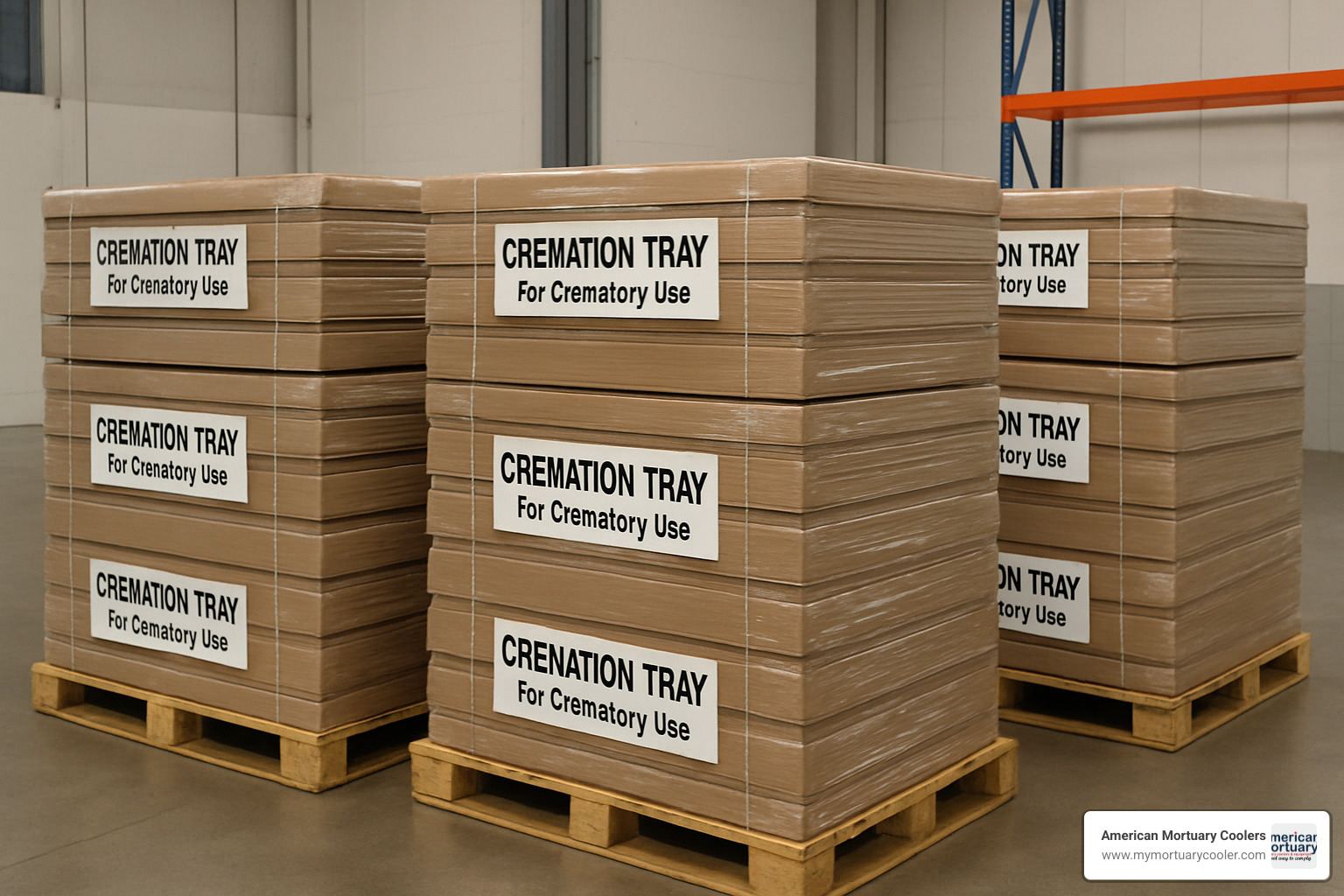
Flat-pack shipping can significantly reduce your freight costs, and standard trays often ship efficiently with 50 per skid. Many suppliers offer free shipping if you meet minimum quantity requirements. Delivery works best to business addresses with loading docks.
At American Mortuary Coolers, we understand the importance of reliable delivery for funeral homes. We offer direct delivery of our mortuary equipment across all 48 contiguous states, and we're happy to help coordinate delivery of complementary supplies like cremation trays so you have everything you need when you need it.
Frequently Asked Questions about Cremation Trays
How is a cremation tray different from a casket or alternative container?
A cremation tray serves a specific purpose that sets it apart from traditional caskets.
Think of a cremation tray as a purpose-built vessel designed specifically for the cremation process. Unlike caskets, which are often crafted with presentation as the primary focus, cremation trays prioritize functionality and efficiency. They're made entirely from combustible materials like cardboard or wood, without any metal components that would interfere with cremation.
Price is another significant difference. While caskets often start at several hundred dollars and can reach into the thousands, cremation trays typically range from $49-$155, making them a more economical choice for families choosing cremation.
The FTC Funeral Rule specifically defines what qualifies as an "alternative container" – essentially an unfinished, non-metal enclosure without ornamentation used to hold remains during cremation. Cremation trays fall neatly into this category, but they're specially engineered for the operational needs of modern crematories.
Are special trays required for infants, children, or oversized remains?
Yes, and using the right size makes a meaningful difference in dignity and safety.
For our smallest angels, proportionally sized cremation trays provide appropriate containment. Infant trays typically measure between 24"-36" in length, while child trays range from 36"-48" and youth trays from 48"-60". These specialized sizes prevent the heartbreaking appearance of remains being "lost" in an adult-sized container.
When caring for larger individuals, standard cremation trays accommodate up to 350-500 pounds, but specialized options are available for additional support. Deluxe 28" width trays can support up to 1000 pounds, while triple-wall 30" width trays are tested to 715 pounds.
Can cremation trays be recycled or disposed of sustainably after use?
While cremation trays themselves are consumed during the cremation process, funeral homes still have several opportunities to improve sustainability in their tray management.
If you find yourself with damaged or unused trays, many can be recycled before use – particularly those made from corrugated materials. Selecting cremation trays made from sustainable materials, like corrugated cardboard with recycled content, naturally reduces your environmental footprint.
Smart ordering practices prevent waste as well. By calculating your needs carefully, you can avoid excess inventory becoming obsolete or damaged in storage. The packaging materials used to ship bulk trays can typically be recycled through standard commercial recycling programs.
For the most environmentally conscious funeral homes, some manufacturers now offer cremation trays made from rapidly renewable materials like willow. These natural alternatives decompose more efficiently and have a lighter environmental impact than traditional options.
Conclusion
The journey through cremation trays reveals just how essential these humble containers are to modern funeral service. As more families across America choose cremation, understanding the full spectrum of tray options becomes increasingly valuable for funeral professionals who want to provide dignified care while running an efficient operation.
I've seen how the right cremation tray can make all the difference—whether it's a basic corrugated model that burns cleanly and efficiently, a specialized viewing tray that helps families say goodbye with dignity, or a robust shipping container that ensures safe transport across state lines or international borders.
What matters most isn't just the tray itself, but how it fits into your overall workflow. The best cremation tray balances practical considerations like weight capacity and material composition with presentation quality and environmental impact. When these elements align with your operational needs and the families' expectations, everyone benefits.
Here at American Mortuary Coolers, we're proud to craft durable, customized equipment that works hand-in-hand with whatever cremation tray solution you choose. Our Tennessee-built mortuary coolers are designed with the complete cremation process in mind, ensuring a seamless transition from refrigeration to final disposition. Whether you're serving families in Atlanta, Chicago, Dallas, New York, or anywhere in between, our direct delivery across the contiguous 48 states brings quality equipment right to your doorstep.
The cremation landscape continues to evolve, and staying informed about best practices and innovations helps funeral professionals provide the highest level of service. We invite you to explore more cremation insights on our website and reach out to discuss how our mortuary equipment can improve your cremation services.
With the right knowledge, equipment, and supplies, your funeral home can offer cremation services that are not only efficient and compliant but also genuinely caring and respectful.


















